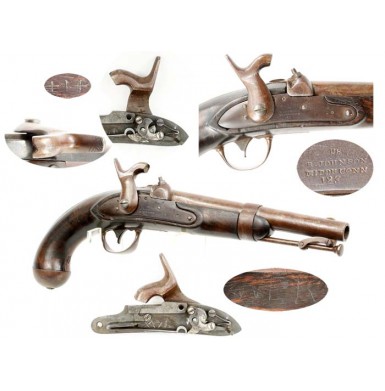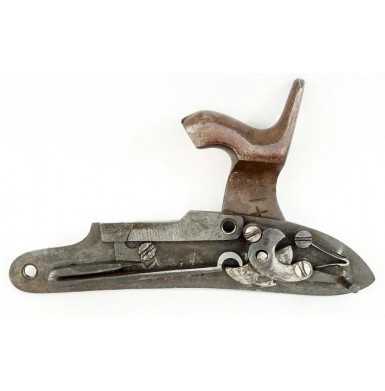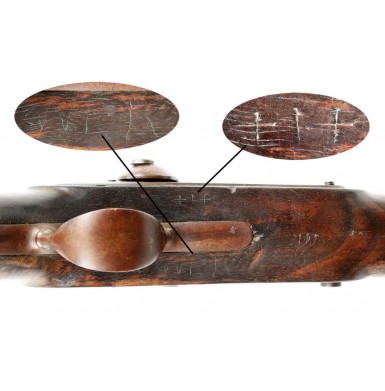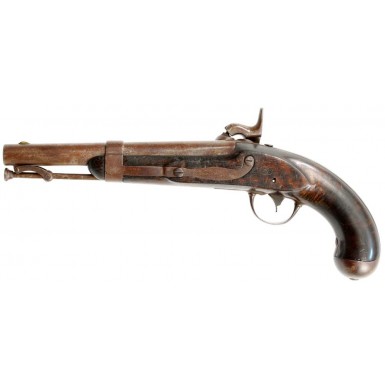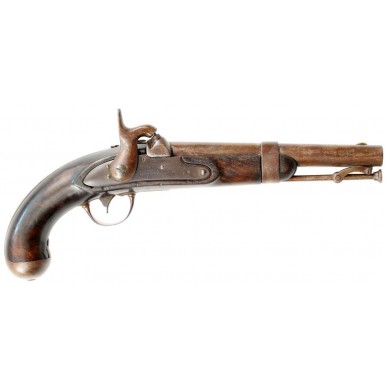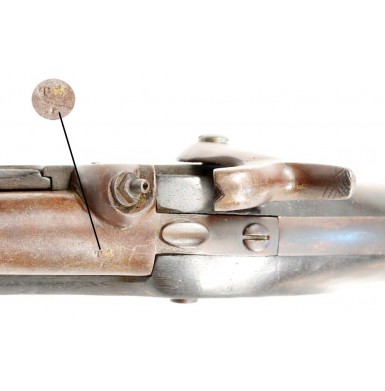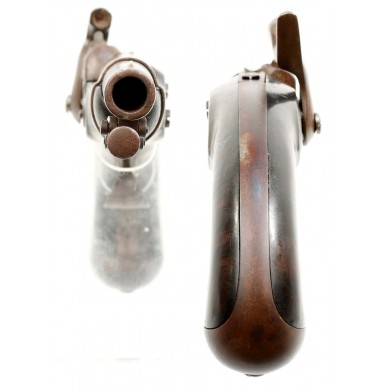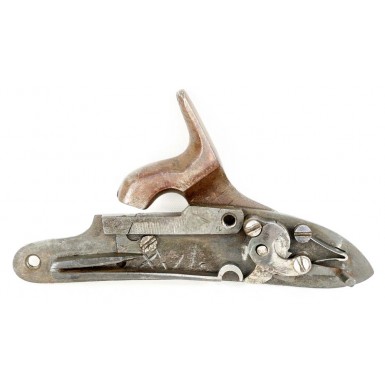Confederate Altered M-1836 Pistol by Adams of Richmond
- Product Code: FHG-1959-SOLD
- Availability: Out Of Stock
-
$1.00
With the coming of the American Civil War, most of the newly seceded southern states found themselves woefully ill-prepared to field and equip an army to withstand President Lincoln’s intention to suppress the rebellion and re-unite the union by force. Most of the southern states had limited quantities of mostly obsolete arms in their various arsenals, and had little (if any) manufacturing to capacity to produce arms. One particular exception to this generalization was the state of Virginia. While the state had a limited number of “modern”, current production percussion rifle muskets, they did have a rather large supply of older flintlock arms in various states of repair, most of which could (and eventually would) be altered to percussion. The state also had the basic structure to establish a state armory to produce small-arms, as the old Virginia Manufactory of arms was located in Richmond. This facility had opened circa 1802 to manufacture small arms for the Virginia Militia and had remained in operation for nearly two decades. The authorities in Richmond were soon scrambling to renovate and reopen this facility and with the addition of machinery captured at Harpers Ferry in April of 1861, the old Virginia Manufactory was soon operating as the new Richmond Armory. The Virginia state government also looked to various contractors to help upgrade their current stores of flintlock muskets, rifles and pistols to percussion. This had actually been going on somewhat aggressively since about 1858, when the state had started to turn in as many flintlock muskets as the Federal Government would allow under the Militia Act of 1808, to have them replaced by percussion altered muskets. The state had also contacted some private vendors like Merrill, Thomas & Company prior to the war, to alter existing stocks of arms to percussion, primarily Virginia Manufactory arms that were in store. With the outbreak of the war, the state proceeded to contract with a number of local gunsmiths and makers to alter as many muskets, rifles and pistols as was practicable. The primary contractors were Thomas J. Adams of Richmond, J.B. (and A.B.) Barrett & co, William Morgan, F. Persignon, S.C. Robinson and the Union Manufacturing Company. Three smaller contractors also did alterations for the state on a much more limited basis, including J.H. Wells, J.D. Brown and S. Holbrook. While the majority of the work performed by these contractors was the percussioning of muskets and a few rifles, three of the contractors also performed alterations to single-shot flintlock pistols. These included J.H. Wells of Staunton (later Charlottesville), William Morgan of Petersburg and Thomas J. Adams of Richmond. The total number of pistols altered by the first two gunsmiths is inconsequential, as Wells altered approximately sixteen pistols for the state of Virginia, and William Morgan appears to have only altered six. These numbers were arrived at based upon the amounts paid to the two men, as the average cost charged to alter a pistol or musket to percussion by the various Virginia contractors was $4.00 each. Only Thomas J. Adams altered what can be considered a significant number of pistols for the state, and it is generally believed he altered about five hundred and seventy pistols. The research presented in Confederate Rifles & Muskets by John D Murphy, M.D. & Howard M. Madaus reveal that three vouchers, numbers 2492, 5165 and 5935 from the state of Virginia show payments to Adams “for altering cav. pistols.” The payments were for $456 on January 1, 1862, $808.50 on May 5, 1862 (noted as “for altering cav. pistols, etc.” and for $548.68 on June 2, 1862. The total of payments on these vouchers related to pistols is $1,813.18. Murphy & Madaus apparently uncovered some other receipts in the amount of $462, as they note that Adams received at least $2,275.18 in payments related to altering pistols. At an average of $4.00 each, this means that Adams altered approximately five hundred and sixty-eight pistols during the first six months of 1862. Adams did not mark his work, but by examining the handful of similarly altered surviving examples, a typology has been established by Murphy & Madaus by which Adams alterations can be identified. Part of this identification is based upon the fact that some of the alterations appear on Virginia Manufactory pistols, which were made is somewhat limited quantities during the first two decades of the 1800s, and which tended to remain within the state of Virginia, thus suggesting any alterations to those guns were likely performed there as well. The Adams alteration involved the application of a “three faceted bolster” to the breech of the pistol by means of brazing it over the touchhole. The pan, frizzen and all parts related to the flintlock battery were removed, and the accompanying holes in the lock filled. The pan on some pistols was filled with iron to create an even surface to help support the flat bottom bolster. As noted, the bolster has three definitive facets, with a flat bottom, followed by an upward angular turn at its rear, which is followed by another upward to nearly 90-degrees, which forms a fence at the rear of the bolster. Many of Adams’ bolsters also show the shadow of a circle on their face, an artifact of the bolster application process, which used a rod through a hole in the bolster to hold it in place while it was brazed, with the hole subsequently being filled in and brazed closed. A crudely made percussion hammer was added to the original tumbler, and most of these hammers show rudely applied, simple cross-hatching on their spurs. As with most alteration work performed on non-interchangeable parts firearms of the period, mating marks were applied to the guns during the process, usually on the inner neck of the hammer, to the inside of the lock, under the barrel (and/or on the rear of the breech plug) and often somewhere on the stock. It is interesting to note that Murphy & Madaus show a number of variations of these marks on altered pistols attributed to Adams, suggesting that either 1) each workman marked his work in his own way, or possibly 2) that Adams was sub-contracting some of the work and the variation in markings is the result of the work be performed at different shops or locations. It is further interesting to note that while most Confederate alterations will show the same mating mark throughout (for example, the Roman numeral IV), many of the Adams alterations will show two sets of mating marks. On some it is believed the other marks are the original assembly marks for the pistol; particularly on the Virginia Manufactory guns, but in other cases it is obvious that the hammer is marked with a completely different mating mark than most of the rest of the gun. I believe that this is again indicative of different workmen doing the work. While one worker may have removed the flintlock parts and applied the bolter, I think a different one was responsible for fitting the hammers to the guns, and he applied his own mating marks. This is similar to British Ordnance contract pistols from the mid-18th through early 19th century that often show two different sets of mating marks, one set for overall assembly and one related to the assembly and fitting of the lock.
Little if known of Thomas J. Adams history prior to working as a contract gunsmith for the Confederacy. According to Murphy & Madaus, Adams had been employed as a gunsmith prior to secession by James Walsh of Richmond, a firearms and sporting goods dealer located at 60 Main Street in Richmond. The 1860 Census shows that T.J. Adams was a resident of the 1st Ward of Richmond in Henrico county, was aged 22 years and was employed as a gunsmith. He resided in a Boarding House owned and operated by Ellen Adams (age 42 and possibly his mother), and the other residents of the home included Mary, Julia C., and William C. Adams, aged 23, 20 and 17 respectively. It is likely that these were Thomas’ brother and sisters. Interestingly, his 17-year-old brother is listed as blacksmith. Other residents of the boarding house include J.C. Walsh (38) who was also a blacksmith, his wife Emma, and four Walsh children ages 5, 9, 11 and 12. Six other residents are also listed in the boarding house, including S. Gregory, a 21-year-old blacksmith, James Manders a 21-year-old clerk, William Lewis and Joseph Lumpkins (26 and 20 respectively) who were both listed as carpenters and Edward Gill, a 23-year-old merchant. From the interesting list of residents, it appears that most (if not all) were probably somehow working for, or in, the Walsh establishment. Examination of existing examples that conform to the Thomas Adams systems of alteration and assembly marking indicate that he performed this work to both Virginia Manufactory pistols as well as US Model 1836 contract pistols by R. Johnson and A. Waters that were acquired by Virginia under the Militia Act of 1808. It is likely that he also performed the alterations on some US Model 1819 contract pistols by Simeon North, as this was the other pattern of flintlock pistol that was delivered to Virginia in some quantity during the first half of the 19th century. A total of 6,907 pistols were received by the state between 1823 and 1848 under the Militia Act, of which it is generally believed that most of the 3,657 pistols delivered between 1823 and 1837 were of the M-1819 contract pattern with the balance of 3,250 being of the M-1836 pattern. To date only a handful of the estimated 570 +/- flintlock pistols altered by Thomas J. Adams have been identified and are known to survive today, making an Adams altered pistol an extremely scarce and desirable early war Confederate alteration.
Offered here is an about FINE condition example of a Thomas J. Adams Altered Confederate Cavalry Pistol. The alteration is performed on a US Model 1836 Flintlock Pistol, delivered as part of Robert Johnson’s contract with the US government. Johnson of Middletown, CT delivered 18,000 US M-1836 Pistols between 1836 and 1844 to Federal Government and it appears that approximately 3,250 US M-1836 pistols (likely a combination of both Johnson and Waters contract guns) were received by the state of Virginia in three groups between 1839 and 1848. The following deliveries of pistols are noted in the Virginia Adjutant General’s reports: 1,400 on October 4, 1839, 850 on August 27, 1841 and 1,000 on September 11, 1848. The pistol shows all of the hallmarks of an Adams alteration. It has the classic “three-faceted” bolster with the circular shadow of the rod used to hold it in place while it was brazed to the barrel. It has the classic, roughly made percussion hammer with crude cross-hatching on the spur. Additionally, it is marked with the large, crudely applied “Roman numeral” reassembly marks found on other altered arms attributed to Adams, and like many of them, shows a mixed set of marks, with the hammer assembly mark differing from the primary assembly mark. The interior of the lock plate and the breech plug are both crudely marked with the assembly mark XVI. However, the hammer is marked on the interior of its neck with what appears to be XIX, but is really + | +, as this same combination of marks, + | + is found on the bottom of the stock to the left side of the triggerguard, with the barrel pointed outward. Interestingly, the initials W E R are lightly scratched on the bottom of the stock on the opposite side of the triggerguard, and appear to have been scratched there a second time, forward of the first set of marks, but they are weak in that location. The lock of the pistol retains its original contract markings, consisting of four lines which read: US / R. JOHNSON / MIDDN CONN / 183”. The last number in the date on the lock is not visible, even under good magnification and appears to have never been struck at all. The upper left of the barrel breech is marked in two lines: TW / P, with the usual “US’ mark not visible above the inspection mark, and again appearing as if it was never struck. The “TW” is the mark of armory sub-inspector Thomas Warner. Warner’s script inspection cartouche appears on the flat opposite the lock, but it is worn and not completely legible. A much clearer second cartouche, a script HKC - the mark of accepting Ordnance Officer Henry Knox Craig, is present on the flat as well and remains quite legible.
As noted, the pistol remains in about FINE overall condition, especially since it had a service life that spanned the era of the Seminole Wars of the 1830s, the Mexican War of 1846-1848 and the American Civil War, having been altered to percussion by Adams during the first half of 1862. While the pistol is complete and correct today, it was missing four parts when it was first found. The trigger, trigger pin, mainspring and hammer screw were all missing from the pistol. They have all been replaced by original US M-1836 parts. Normally small parts like this, if original and of the period have no bearing on the condition or value of a gun as screws, lock parts and springs were often broken or damaged during the period of use, necessitating repairs. The only difference is that I know these parts were replaced recently, and not during the period of use. This is disclosed in an effort to accurately describe the pistol. If I did not mention it, it is unlikely that anyone would know that these original parts were not original to the gun. The balance of the parts all appear to be original to the period of use. The pistol remains quite well marked throughout, with only the sub-inspection cartouche being particularly difficult to read. The .54 caliber 8.5” long, round, smoothbore barrel has a lovely, uncleaned brown patina over all of the exposed surfaces and the iron furniture has a similar matching patina. The barrel is mostly smooth, showing only some light to moderate pinpricking around the breech and bolster area and at the muzzle. The balance of the barrel shows only some lightly scattered pinpricking and scattered light surface oxidation. There appear to be some minor traces of old gold paint in the nooks and crannies of the barrel, suggesting that this gun may have spent time on the wall of a G.A.R. Hall as part of their display of captured southern arms. The bore of the pistol is dark and somewhat dirty, showing light to moderate pitting along most of its length. The lock has the same slick, brown oxidized patina as the balance of the pistol and remains in fine mechanical condition, functioning exactly as it should on all positions. The swivel ramrod in the channel under the barrel appears original to the pistol and shows good age, but small receptacle at the end of the rod that was threaded to accept cleaning implements is broken off the rod and missing. The button head and swivel mechanism remain intact and the rod functions smoothly, although with the female threaded cup missing from the end of the rod, it can now be removed from the swivel mount with no effort at all. The stock of the pistol rates about FINE as well and remains very crisp throughout, with good lines and edges. The stock appears uncleaned and un-sanded and has a lovely burnished patina like a well-used banister. The stock shows the usual assortment of scattered bumps, dings and mars from service and use, but no real abuse. There is a small chip of wood missing at the lower rear edge of the lock mortise, and some minor wood loss on the reverse at the trigger pin hole. A couple of very minor surface grain cracks are present as well, but nothing serious or structural. The stock remains solid and complete with no breaks, repairs or structural cracks noted.
Overall this is a very crisp and attractive example of a scarce Confederate Used US M-1836 Pistol -Altered by Thomas Adams of Richmond. According to the information in Confederate Rifles & Muskets by Murphy & Madaus, only five examples of Adams altered US M-1836 pistols were known at the time the book was written. While it is likely that at least a few more examples have surfaced since the book was published in 1996, it is reasonable to assume that somewhere between 10 and 15 survive today and certainly less than 20. With only about 570 of these pistols being altered by Adams during the first half of 1862 and considering the rather paltry survival rate of Confederate made and altered arms, it is not likely that any more of these pistol (which were completely obsolete when the war started) would have survived to after the war in the cartridge era. For any serious collector of southern-made and altered arms, this is one of those “must have” items. It is an identifiable alteration from a Richmond gunsmith who only altered a few hundred pistols, and it is a great example of how necessity forced the Confederacy to waste time, money and resources to alter thoroughly obsolete single shot flintlock pistols to percussion in an attempt to arm its cavalry early in the war. This gun would be a great addition to any Confederate arms collection or display, particularly one that centers on Confederate alterations, Richmond made and altered arms or Confederate cavalry arms. Don’t miss your chance to own such a fine example of a scarce Confederate altered pistol, for the price of a mid-grade Colt revolver! A diligent researcher may eventually be able to mate the initials carved on this pistol with those of a Virginia cavalryman who was issued an altered single shot pistol, allowing the owner to fully identify this rare, Confederate altered pistol to a specific soldier.
Tags: Confederate, Altered, M, 1836, Pistol, by, Adams, of, Richmond

